Have you at any time come across limitations to expanding your network due to a fiber shortage? Alternatively, what if you could double your network capacity without having to lay additional fiber, thus saving time, money, and trouble?
A 1G BiDi SFP module allows you to transmit data in both directions over a single optical fiber. This technology allows for considerable fiber reductions and decreases deployment costs.
By taking a closer look at how it works, technical specifications, installation tips, and real-life deployments, you can educate network professionals to develop simplified and economical single-fiber networking solutions.
By studying these concepts, you will be more knowledgeable and confident in deploying 1G BiDi SFP modules with ease and maximizing your network performance.
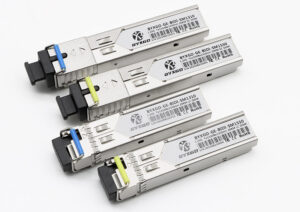
1G BiDi SFP Product Lineup: Find the Perfect Solution for Your Network
The 1G BiDi SFP product category features wide compatibility in devices and switch vendors, allowing for seamless integration. Designed for stable, high-performance operation, these modules handle a variety of distances and fiber applications to meet various networking demands.
Here are some highlights of the module family:
- BiDi SFP 1G 10km (1310nm Tx / 1550nm Rx): Most qualified for standard campus links in an effective single-fiber usage application.
- BiDi SFP 1G 40km (1550nm Tx / 1310nm Rx): Extreme reach was considered with a proven fiber-saving application.
- BiDi SFP 1G 80km: While needing extreme range single-fiber transmission, it considers power budget and sensitivity.
- Fiber Saving SFP Modules: The right choice when fiber conservation is a consideration, and they are compact in a dense data center environment.
Each module also provides sufficient diagnostics and meets leading industry standards for plug-and-play, while physical compatibility makes it easy to install in a standard SFP port, which smooths the upgrade or replacement.
This multitude of choice gives the network planner the ability to choose the correct 1G BiDi SFP module, optimize the use of fiber, and provide sufficient data integrity.
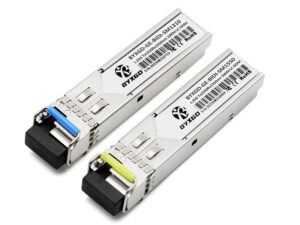
BYXGD-SFP-BIDI-1.25G-Tx1310/Rx1550nm-10KM: This BiDi 1.25 Gb/s module transmits at 1310 nm and receives at 1550 nm over 10 km of single-mode fiber. It has an FP laser with output power of -3 to -9 dBm and a PIN photodiode receiver with a sensitivity of ≤ -22 dBm. LC/SC connectors are provided, and the device supports bidirectional data transmission on a single fiber, thus saving cabling costs and streamlining network installation.
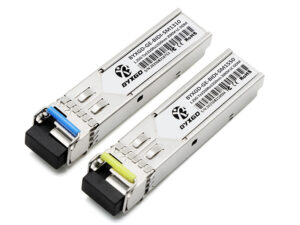
BYXGD-SFP-BIDI-1.25G-Tx1310/Rx1550nm-20KM: Operates at a transmission rate of 1.25 Gb/s for distances of 20 km over single-mode fiber at a wavelength of 1310 nm, and a receive distance of 20 km over single-mode fiber at a wavelength of 1550 nm. The module features a DFB laser with an output power range of 0 to -5 dBm with a receiver sensitivity ≥ -24 dBm. The module is available with LC/SC connectors for reliable long-distance data transmission for network applications.

BYXGD-SFP-BIDI-1.25G-Tx1310/Rx1550nm-40KM: This 1.25 Gb/s unit sends at 1310 nm and receives at 1550 nm over 40 km single-mode fiber. This transceiver has a DFB laser, which can output from 0 to -5 dBm and has a minimum receiver sensitivity of ≤ -24 dBm. Additionally, this unit is compatible with either LC or SC connectors for long-distance data transmission.
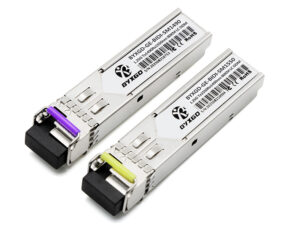
BYXGD-SFP-BIDI-1.25G-Tx1490/Rx1550nm-80KM: This 1.25 Gb/s module offers 1550 nm transmission and 1490 nm reception over an 80 km single-mode fiber. It utilizes a DFB laser with a power range of 0 to 3 dBm and receiver sensitivity of -26 dBm. It is compatible with LC/SC inputs, making it a reliable option for long-range data transmission on high-speed networks.
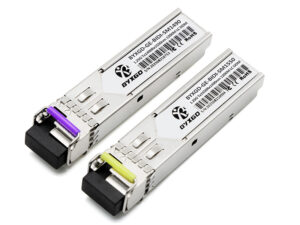
BYXGD-SFP-BIDI-1.25G-Tx1490/Rx1550nm-120KM: This 1.25 Gb/s module uses 1550 nm transmission and 1490 nm reception over 120 km of single-mode fiber. It has a DFB laser, which can output a power between 0 and 3 dBm and has a receiver sensitivity of ≤ -34 dBm. It is compatible with LC/SC connectors, which support more reliable long-distance data transmission for high-performance networks.
1G BiDi SFP: The Secret Weapon for Fiber and Cost Savings
The 1G BiDi SFP module changes how we use fiber by sending and receiving data from one fiber strand. Traditional duplex SFPs used two fiber strands, one for sending and one for receiving. By combining the signals on one fiber using BiDi technology, the physical fiber requirement is drastically reduced.
The 1G BiDi SFP module uses wavelength division multiplexing (WDM) to operate. Each SFP module can transmit and receive data using different wavelengths. For example, a common pair of wavelengths includes 1310 nm for sending and 1550 nm for receiving. The benefit is that two signals can share the same fiber without interference. Think of it this way: two cars drive in opposite directions on a one-lane bridge, but each car has its own lane.
The savings extend beyond just fiber count. Reducing the number of fiber strands will save on installation costs, including cabling, conduit, and labor. Deploying a network is easier and faster because it reduces the amount of fiber required to deploy. Rapidly deploying upgrades and expansions is also easier. Less physical fiber means less disruption.
In markets where the availability of fiber is limited, such as data centers, campuses, or metro networks, the 1G BiDi SFP modules are an effective way to conserve the use of fiber without sacrificing performance. It will also reduce the amount of physical fiber and the management and maintenance of physical cabling.
To read more about BiDi technology, including additional applications, advantages, and market developments, please refer to the BiDi Optical Modules Article. In short, the 1G BiDi SFP is an effective, low-cost fiber solution that utilizes optical technology to conserve fiber resources as efficiently as possible to continue to speed up the deployment of fiber networks.
Technical Specs and Selection Criteria: In-Depth Review of 1G BiDi SFP Performance
Technical specifications are critical in determining the strength and compatibility of 1G BiDi SFP modules. Each module utilizes two different wavelengths—most often the transmitting wavelength is 1310 nm and the receiving is 1550 nm (or the other way around). This is necessary to enable bidirectional communication over single-mode fiber and does not cause interference.
Distance limitations of 1G BiDi SFP modules vary based on the model; distance limits are typically 10 km, 40 km, or up to 80 km. To maintain signal strength, longer distances require greater power budgets. Transmitter output power must be increased, and receiver sensitivity must be improved to reliably transmit data over longer distance fiber runs.
Data rates standardize at 1.25 Gbps line rate to comply with requirements for Gigabit Ethernet and compatibility with the current network architecture. At the same time, power budgets range from a 12 dB budget for shorter lengths to 24 dB on longer links.
The correct match of Tx/Rx wavelength pairing is critical, as mismatched wavelengths will block communication completely. Network engineers must identify whether connected modules have the correct paired wavelengths to keep the modules working reliably.
BiDi vs Duplex SFPs
| Feature | 1G BiDi SFP | Traditional 1G Duplex SFP |
| Fiber Utilization | Single fiber for both Tx/Rx | Two fibers (one Tx, one Rx) |
| Module Count | One per endpoint | One per endpoint |
| Installation Complexity | Lower (less cabling) | Higher (more fibers and terminations) |
| Deployment Cost | Reduced due to fiber saving | Higher due to fiber and labor |
| Recommended Use Cases | Fiber-constrained or high-density sites | Standard duplex fiber networks |
Selecting 1G BiDi SFPs provides significant fiber savings, with fewer required installation points and less hassle for cabling. Standard duplex SFPs remain usable where fiber is plentiful or backward compatibility is needed to support older systems.
Ultimately, in assessing 1G BiDi SFP modules, the following criteria and points are worthy of consideration:
- Tx/Rx wavelength pairing: Complementary pairs must match to allow bidirectional data flow.
- Distance and attenuation power budget: Make sure that the module specifications are within the limits designated for the link length and related distance specifications.
- Compatibility: Confirm that the transceiver module works with your device type and fiber infrastructure.
- Cost vs. complexity: Consider the upfront and back-end costs to compare cost with the complexity of increased cabling and installation.
Interpreting these criteria will help determine the right 1G BiDi SFP module for your unique network conditions and allow for efficient usage of fiber with no decrease in network performance.
BiDi vs Duplex Installation Aspects
| Aspect | BiDi SFP | Duplex SFP |
| Cabling | Single fiber for transmission | Two fibers (separate Tx & Rx) |
| Installation | Lower fiber management complexity | Higher due to more fiber links |
| Polarity | Requires precise wavelength pairing | Standard duplex polarity |
| Troubleshooting | Must check Tx/Rx wavelengths | Easier due to physical separation |
For more extensive compatibility information, check the official SFP Compatibility Guide for networking devices and brands. By following these steps, you can ensure a 1G BiDi SFP module works properly in your network, optimizing fiber utilization without introducing possible installation errors.
Real-World 1G BiDi SFP Deployment Shows Dramatic Fiber Savings
A regional university faced the task of upgrading the campus network. With existing fiber already in use between buildings, any fiber build-out would be challenging and expensive. If they used duplex fiber (two fibers for each link), that would effectively double the fiber runs and create further cost and installation time.
However, the university decided to implement 1G BiDi SFP modules, which allowed them to leverage bidirectional transmission over a single fiber, thus halving their fiber usage. They were able to use the existing fiber strands without incurring the cost of running new cabling or conduit.
According to the university, installation was completed in record time, reducing deployment time from weeks to days. The project saved more than 500 meters of fiber, roughly 40% of the fiber material and labor costs. Reliability improved too, as the cabling was simplified, which reduced the number of failure points.
This case demonstrates how 1G BiDi SFP modules provide fiber savings and cost-effective solutions. Institutions looking to expand fiber connectivity where fiber was previously constrained or high-density networking became barriers would benefit from this technology, which proves its real operational and financial value!
Frequently Asked Questions
Yes. They are designed to work on standard single-mode fiber, and therefore can easily be plugged into any existing fiber network where you do not need any special fiber types.
1G BiDi SFP modules use a single fiber to transmit and receive data on different wavelengths. Conversely, ordinary duplex SFPs require two fibers—one for each direction. A visual difference is BiDi modules may have markings of the two different wavelengths to identify Tx and Rx.
You will require single-fiber patch cables compatible with the BiDi modules. These single-fiber patch cables are not the same as duplex fiber cables, as they carry both Tx and Rx signal through the same fiber. Therefore, duplex fiber cables will not work properly due to the distinct signal patterns.
Typical distances are 10 km, 40 km, and 80 km depending on the module’s power budget and quality of the fiber.
You may wish to review the compatibility matrix for the switch vendor and firmware version—to ensure that it supports BiDi transceivers. You can also refer to the BiDi Hub or product category pages for additional information and compatible listings.
Contact Us For The Best Solution
Deploying 1G BiDi SFP modules contributes considerable fiber savings and lower cabling burden, bringing reduced cost overall, and resolving fiber issues for future expansions.
The technology provides efficient and scalable network deployment options without sacrificing performance and reliability.
Finally, the product catalog provides additional options to find the right 1G BiDi SFP modules to support your network’s needs. If you would like to learn more about compatibility or have deployment questions, please contact technical support teams for advice. Support teams can help make transitions easier for your organization and fiber savings technology.
